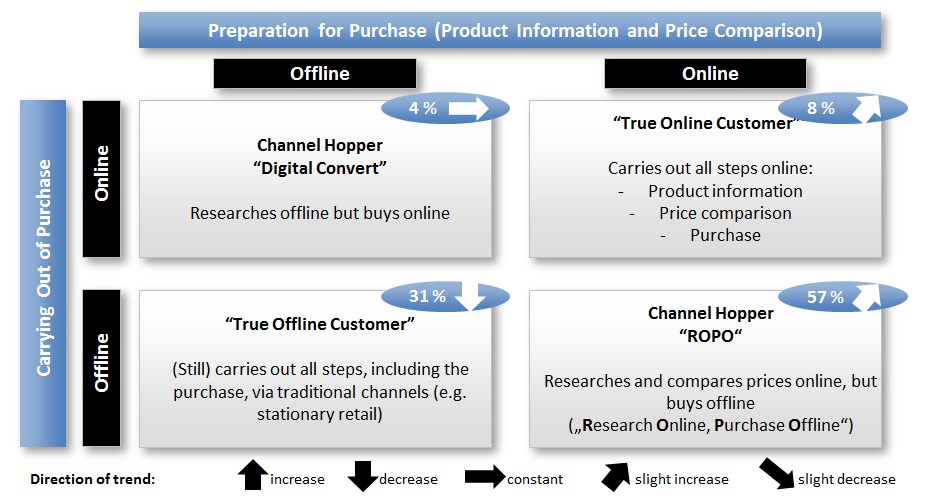E-Commerce for Stationary Retail
The Current Challenges of Stationary Retail
Though the stationary retail model has proven its effectiveness over centuries, the “offline to online” channel shift is placing it under increasing pressure – so reported German business news magazine WirtschaftsWoche in a report from March 2013 about “large-scale shop closures”. Online giants like Amazon or Zalando are currently placing stationary retail under such pressure that many retailers are fearful for their survival. Stationary retail is suffering from the fact that increasing numbers of consumers are ordering items like notebooks, books, shoes and more via the PC, tablet or smartphone – either on-the-go or from the comfort of their homes. In fact, a recent forecast from German economist Dr. Gerrit Heinemann of the Niederrhein University of Applied Sciences predicted that online retail would account for at least 15% of total retail sales in the year 2015. Assuming that this is true, it implies a growth of around 128% in the online retail market for the period 2012-2020, while total retail sales are on course to grow by just 5% during the same period. Adjusted for the growth rate of online retail, the retail sector as a whole is actually projected to shrink by around 4.5%, with the stationary retail trade losing market shares in the process (chains like the German Görtz, who have had to close successive stores, are already feeling this effect). In spite of this, pure online players like eBay, Amazon, notebooksbilliger.de and Google are pursuing a counter-path and attempting to inject the brand experience back into stationary retail. This offline push by pure online players shows that opportunities are still present in the stationary retail trade. In this so-called “online to offline” approach, pure players have a chance to put the excellent quality of their customer data – collected in the course of their online retail activities – to beneficial use. Such data enables them to carry out optimal location analyses and to gain other types of insights. While the strides made by pure players in the stationary retail trade will doubtless make it stronger, the intensity of competition for existing retailers is also set to increase further. Companies lacking a multi-channel or no-line strategy should be concerned for their future existence, since the are unlikely to be able to successfully tackle the impending transition into stationary retail’s digital future.
The Digital Future of Stationary Retail
The developments mentioned above make clear has most stationary retail has most definitely passed its heyday. Today, it is only a small subsection of customers – the “early adopters” who are seen in supermarkets with their smartphones – who still compare stationary retail prices with those available on the internet, via barcode scanners and their corresponding applications. The following diagram makes clear, however, that the internet already plays a role in the purchasing process for 70% of all purchases in Germany today. The diagram also shows that the number of people completing all steps towards a purchase via the traditional channels (“true offline” in the following diagram) are decreasing, while the number of people completing all such steps online (“true online” in the following diagram) is simultaneously on the increase.
At 57%, the “channel changers” – who learn about a product online but purchase it in a physical store – are not only the biggest category of customers currently, but look set to increase in number. It’s in this ROPO (research online, purchase offline) effect that the future potential of stationary retail lies. In practice, stationary retailers can now be divided broadly into two categories: those who outright reject online opportunities; and multi-channel pioneers. In between these two, there reigns a great deal of confusion amongst many stationary retailers regarding the rather expansive “jungle” that e-commerce represents. Yet modern commercial structures are not only a key success factor for the stationary retail trade – they are also crucial for its survival. Just as for manufacturing companies, it is therefore essential for stationary retailers to develop an effective e-commerce strategy.
FOSTEC helps make stationary retailers future-proof by offering targeted advice on the current challenges of the offline-to-online channel shift. We provide guidance on topics including (but not limited to) the following:
- Modern commercial structures for stationary retail
- Digital future of stationary retail
- E-commerce strategies for stationary retail
- StatusQuo and system analysis
- Web-to-Store: e.g. expansion of an online business in the “offline” world
- Store-to-Web: e.g. stationary business on the net
- Web-in-Store: e.g. in-store use of the internet
- The role of the internet in customer service
- LBS, mobile and QR commerce
- Mobile payment
- E-commerce business processes for stationary retail
- Web presence and online shops for stationary retailers
- Changes brought about by the developing “Internet of Things”
- Augmented reality applications
- Online marketing concepts for stationary retail
- Datamining and BI
- NFC applications
- Product assortment policies for stationary retail
- Pricing policies for stationary retail
- Dealing with marketplaces such as Amazon and eBay
- Dealing with pure players
- Possible e-commerce operational approaches for stationary retail
- IT system landscapes for stationary retail
- Search engine optimisation (SEO) for stationary retail
- Organisation of e-commerce in stationary retail
- Distribution strategies for stationary retail
- Options for the online presence of a stationary retailer
- Formation of future-oriented stationary retail business model
- Determination of the characteristics of your stationary retail operation
- Recruiting and training
- and many more
Want to learn more? FOSTEC recommends the book „No-Line-Handel“ by Prof. Dr. Gerrit Heinemann.



